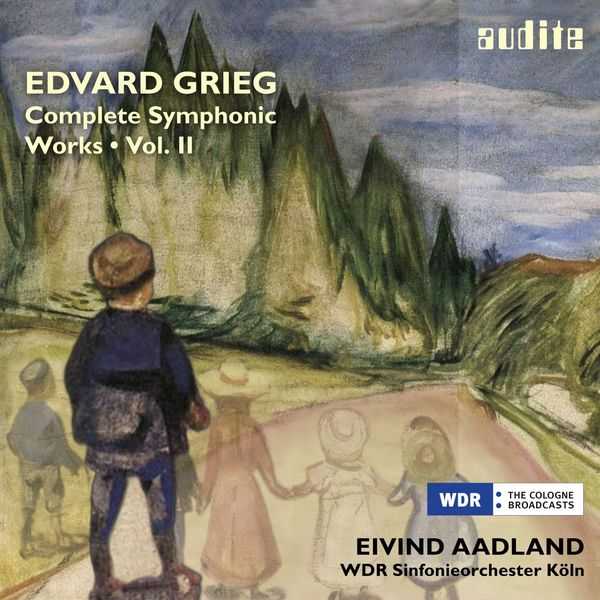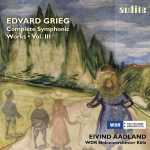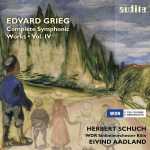

Composer: Edvard Hagerup Grieg
Orchestra: WDR Sinfonieorchester Köln
Conductor: Eivind Aadland
Format: FLAC (tracks)
Label: Audite
Catalogue: AUDITE92579
Release: 2011
Size: 533 MB
Recovery: +3%
Scan: cover
Two Elegiac Melodies, Op. 34
01. No. 1, Hjertesar (the Wounded Heart)
02. No. 2, Varen (Last Spring)
Holberg Suite, Op. 40
03. I. Prelude (Version for Strings)
04. II. Sarabande (Version for Strings)
05. III. Gavotte (Version for Strings)
06. IV. Air (Version for Strings)
07. V. Rigaudon (Version for Strings)
Melodies Op. 53
08. No. 1, Norsk (Norwegian) [Version for orchestra]
09. No. 2, Det forste mode (the First Meeting) [Version for orchestra]
Two Nordic Melodies, Op. 63
10. No. 1, I folketonestil (In folk style) [Version for orchestra]
11. No. 2, Kulok (Cow-Call) [Version for orchestra]
12. No. 2, Stabbelaten (Peasant Dance) [Version for orchestra]
This second volume, in a five-part series of the complete symphonic works with Eivind Aadland and the WDR Sinfonieorchester contains the works for string orchestra: a genre which Grieg mastered like no other, chiefly arrangements of songs and piano pieces. Where the song arrangements of the Elegiac Melodies Op. 34 and the Two Melodies Op. 53 were a form of ‘export edition’ for non-Scandinavian countries (where they were extremely popular, even during Grieg’s lifetime), the famous suite From Holberg’s Time Op. 40 is a homage to Ludvig Holberg, the caustic ‘Molière of the North’, whose 200th birthday was celebrated in Bergen in 1884. For this occasion, Grieg composed a suite ‘in the old style’ on dance forms of the late baroque (Holberg’s own time) without, however, denying his own, romantic style. The late Nordic Melodies Op. 63 were written by the 51-year-old Grieg who was touring internationally as a conductor and who, in the absence of major works, broadened his repertoire with smaller pieces.
“The flavour of this music is in my blood”, says the conductor Eivind Aadland, who grew up in Grieg’s hometown of Bergen and who today is an international artist. Aadland was chief conductor and artistic director of the Trondheim Symphony Orchestra from 2003 until 2010 and has also worked with many other Scandinavian, European and international orchestras. He initially studied the violin with Yehudi Menuhin. From 1981 until 1989 he was concert master of the Bergen Philharmonic and from 1987 until 1997 music director of the European Union Chamber Orchestra. He subsequently devoted himself fully to his conducting career and studied with Jorma Panula.
Like Vol. 1 of Audite’s survey of Edvard Grieg’s complete symphonic music, Vol. 2 cleverly combines familiar with more obscure. The part of familiar is filled by the Holberg Suite for string orchestra. It is curious that this should be one of Grieg’s most well-known works as the composer was intentionally subduing the folkloric and nationalistic characteristics that defined him in favor of capturing the feeling of a Baroque dance suite. The majority of the remaining works on the album focus on Grieg’s own transcriptions for string orchestra of his popular (in Norway) songs. The omission of the text from these songs has little impact on Grieg’s unmistakable idiom, folksy charm, and rhythmic vitality. Performed by the WDR Sinfonieorchester Köln under veteran Scandinavian conductor Eivind Aadland, these works spring to life through Audite’s rich, vibrant sound; spaciousness and extraordinary detail are especially noticeable on the album’s SACD layer. Aadland’s upbringing surrounded by Grieg’s music is obvious in the natural, almost effortless way that he guides the orchestra, drawing out the elegant, vocal qualities of the compositions while simultaneously highlighting the rhythms and harmonies that characterize Grieg’s folk popularity. The orchestra’s strings play with warmth and clarity and an exceptional dynamic range.



